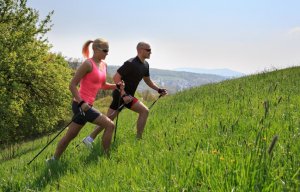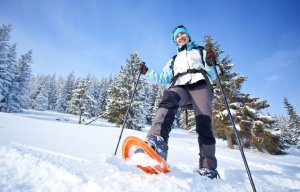How to Practice Snowshoeing

It’s not necessary to travel to Finland (or another Scandinavian country) to practice Snowshoeing, an increasingly fashionable exercise in cities without mountains or snow. In this article, we’ll tell you more about this discipline and its several advantages.
What is snowshoeing?
Snowshoeing includes movements from skiing, but instead of skis, we wear snowshoes. If you need trekking poles, you can also use these for balance.
Despite what you may think, it’s not a new discipline. The first time it was practiced was in the 1930s. At that time, athletes who practiced cross-country skiing used it as a way to continue training outside of the winter season.
Historically, when walking or running through the woods and fields, athletes could keep fit outside the winter skiing season. And just before the end of the last millennium, a physical education student in Finland wrote a thesis to about the benefits of snowshoeing.

Special trekking poles for snowshoeing are now available. Thousands of followers around the world now enjoy this discipline due to its multiple benefits.
If we snowshoe for one hour, we’ll be walking about 6,000 steps, and making the same number of arm movements.
During that time we’ll move around 600 muscles and burn about 400 calories. In the common walk -without trekking poles- 200 muscles move and we burn around 140 calories. This doesn’t include arm thrusts, only steps.
How is snowshoeing practiced?
To perform this discipline, you only need a pair of special fiberglass and carbon rods, which are available in sports stores.
Keep in mind that they aren’t the same as those used for hiking since those in snowshoeing have an oblique block in the lower part, for greater surface support. You can change the edge according to the terrain that you’re walking on.
The length of the trekking pole should be the same as that of our arms (or two-thirds of our height). And it’s held through a wristband so that they hang when we aren’t using them. For this practice, it’s also essential to have comfortable sports clothes appropriate to the place: for example for the mountain, forest or city.
Then, we walk ‘normally’ but exaggerate our arm movements and the trekking poles will touch the ground with each step we take. The objective is to walk at a medium to fast speed, starting on level ground. Then, with practice, you can walk on a hill or sand dune, for example.

Level terrains, such as a park or field can also make us work harder increasing the speed and the interaction between the arms and the legs.
Like all outdoor physical activity, it’s recommended not to forget sun protection, a hat, and sunglasses. Of course, you also need to consider the weather and the temperature. Wear shorts and sleeveless clothes on summer days, or dress in layers in winter.
Finally, you should know that snowshoeing has many benefits, such as improving cardiorespiratory function, losing weight, increasing muscle coordination and even reducing stress, because it’s an aerobic exercise.
It’s not necessary to travel to Finland (or another Scandinavian country) to practice Snowshoeing, an increasingly fashionable exercise in cities without mountains or snow. In this article, we’ll tell you more about this discipline and its several advantages.
What is snowshoeing?
Snowshoeing includes movements from skiing, but instead of skis, we wear snowshoes. If you need trekking poles, you can also use these for balance.
Despite what you may think, it’s not a new discipline. The first time it was practiced was in the 1930s. At that time, athletes who practiced cross-country skiing used it as a way to continue training outside of the winter season.
Historically, when walking or running through the woods and fields, athletes could keep fit outside the winter skiing season. And just before the end of the last millennium, a physical education student in Finland wrote a thesis to about the benefits of snowshoeing.

Special trekking poles for snowshoeing are now available. Thousands of followers around the world now enjoy this discipline due to its multiple benefits.
If we snowshoe for one hour, we’ll be walking about 6,000 steps, and making the same number of arm movements.
During that time we’ll move around 600 muscles and burn about 400 calories. In the common walk -without trekking poles- 200 muscles move and we burn around 140 calories. This doesn’t include arm thrusts, only steps.
How is snowshoeing practiced?
To perform this discipline, you only need a pair of special fiberglass and carbon rods, which are available in sports stores.
Keep in mind that they aren’t the same as those used for hiking since those in snowshoeing have an oblique block in the lower part, for greater surface support. You can change the edge according to the terrain that you’re walking on.
The length of the trekking pole should be the same as that of our arms (or two-thirds of our height). And it’s held through a wristband so that they hang when we aren’t using them. For this practice, it’s also essential to have comfortable sports clothes appropriate to the place: for example for the mountain, forest or city.
Then, we walk ‘normally’ but exaggerate our arm movements and the trekking poles will touch the ground with each step we take. The objective is to walk at a medium to fast speed, starting on level ground. Then, with practice, you can walk on a hill or sand dune, for example.

Level terrains, such as a park or field can also make us work harder increasing the speed and the interaction between the arms and the legs.
Like all outdoor physical activity, it’s recommended not to forget sun protection, a hat, and sunglasses. Of course, you also need to consider the weather and the temperature. Wear shorts and sleeveless clothes on summer days, or dress in layers in winter.
Finally, you should know that snowshoeing has many benefits, such as improving cardiorespiratory function, losing weight, increasing muscle coordination and even reducing stress, because it’s an aerobic exercise.
This text is provided for informational purposes only and does not replace consultation with a professional. If in doubt, consult your specialist.








